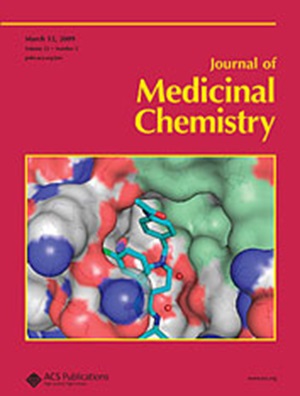Lysine-Targeted Covalent Strategy Leading to the Discovery of Novel Potent PROTAC-Based PI3Kδ Degraders
IF 6.8
1区 医学
Q1 CHEMISTRY, MEDICINAL
引用次数: 0
Abstract
Proteolysis-targeting chimera (PROTAC) technology was employed to achieve the degradation of PI3Kδ in this study, and a series of PROTAC-based PI3Kδ degraders were first developed. Lysine-targeted covalent strategy led to the discovery of novel potent PROTAC-based PI3Kδ degraders. After screening and structure–activity relationship study, B14 was optimal and exhibited strong antiproliferation and selective PI3Kδ inhibition, with a high degradation value (DC50 = 3.98 nM). B14 induced cell cycle arrest in the premitotic phase and prompted cell apoptosis. B14 displayed effective suppression of the tumor growth in the xenograft model and significantly promoted the PI3Kδ degradation in vivo. Most importantly, B14 bound to the Lys779 of PI3Kδ to selectively degrade PI3Kδ by covalent-bonding. Mechanistic studies indicated that the ubiquitin-proteasome pathway was involved in the degradation process. This study provided an effective approach for developing PROTAC-based PI3Kδ degraders, and the lysine-targeted covalent strategy laid the foundation for the further design of potent PI3Kδ-targeting PROTACs.

赖氨酸靶向共价策略导致发现新的有效的基于protac的PI3Kδ降解物
本研究采用蛋白水解靶向嵌合体(Proteolysis-targeting chimera, PROTAC)技术实现PI3Kδ的降解,并首次开发了一系列基于PROTAC的PI3Kδ降解物。赖氨酸靶向共价策略导致了基于protac的新型高效PI3Kδ降解物的发现。经过筛选和结构-活性关系研究,B14是最优的,具有较强的抗增殖和选择性抑制PI3Kδ,降解值高(DC50 = 3.98 nM)。B14诱导细胞周期阻滞于有丝分裂前期,促进细胞凋亡。在异种移植瘤模型中,B14能有效抑制肿瘤生长,并显著促进PI3Kδ在体内的降解。最重要的是,B14结合到PI3Kδ的Lys779上,通过共价键选择性地降解PI3Kδ。机制研究表明,泛素-蛋白酶体途径参与了降解过程。本研究为开发基于protac的PI3Kδ降解物提供了有效途径,赖氨酸靶向共价策略为进一步设计高效的PI3Kδ靶向PROTACs奠定了基础。
本文章由计算机程序翻译,如有差异,请以英文原文为准。
求助全文
约1分钟内获得全文
求助全文
来源期刊

Journal of Medicinal Chemistry
医学-医药化学
CiteScore
4.00
自引率
11.00%
发文量
804
审稿时长
1.9 months
期刊介绍:
The Journal of Medicinal Chemistry is a prestigious biweekly peer-reviewed publication that focuses on the multifaceted field of medicinal chemistry. Since its inception in 1959 as the Journal of Medicinal and Pharmaceutical Chemistry, it has evolved to become a cornerstone in the dissemination of research findings related to the design, synthesis, and development of therapeutic agents.
The Journal of Medicinal Chemistry is recognized for its significant impact in the scientific community, as evidenced by its 2022 impact factor of 7.3. This metric reflects the journal's influence and the importance of its content in shaping the future of drug discovery and development. The journal serves as a vital resource for chemists, pharmacologists, and other researchers interested in the molecular mechanisms of drug action and the optimization of therapeutic compounds.
 求助内容:
求助内容: 应助结果提醒方式:
应助结果提醒方式:


